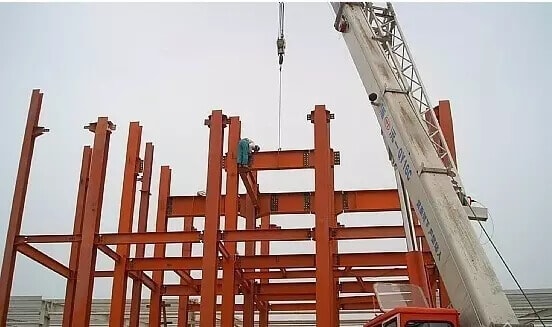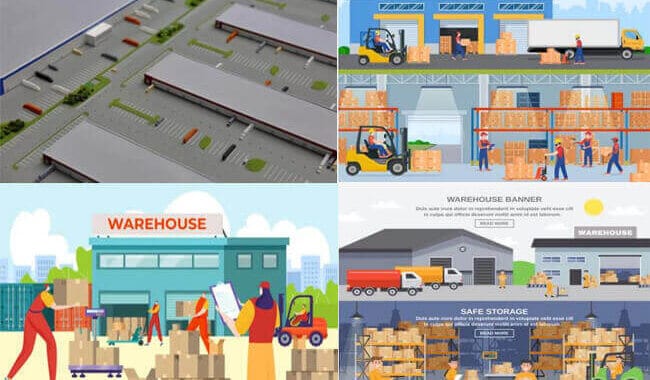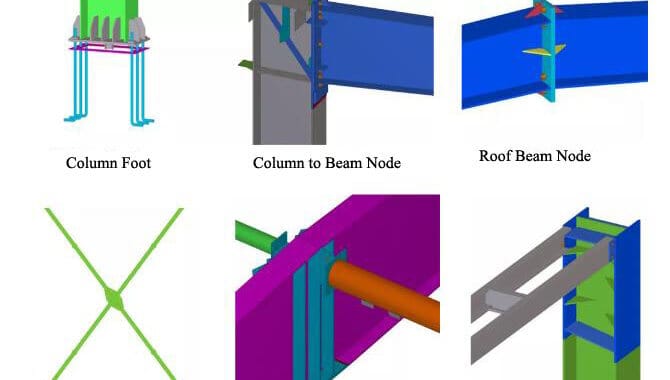Steel structure splicing includes splicing in the workshop and on-site. The splicing methods include welding and bolting. We should implement…
Steel structure detail explores the specifications and principles of the most commonly used steel structures in construction, including portal steel frames, multi-layer steel frames, and truss structures. These structural forms are widely used in various buildings, such as warehouses, factories, office buildings, stadiums, transportation hubs, and hangars.
Type of Steel Structure
Portal frame structure: Portal frames have the advantages of being lightweight, large in span, economical, and environmentally protected. They are widely used in warehouses, factories, and agricultural buildings.
Multi-layer steel frame structure: Steel frame structures are flexible in spatial design and are suitable for multi-story buildings. Their adaptability makes them ideal for office, residential, or high-rise buildings.
Truss structure: Spatial truss structures are designed for large-span, large-space buildings. For example, the truss structure used in gymnasiums can support buildings with spans of more than 50 meters. Its design minimizes the use of materials while maintaining high strength and stability.
Steel Structure Introduction
Steel structures are made of structural steel connected and arranged to carry loads and provide rigidity. Due to their high strength, durability, and various infrastructure projects, steel structures are often used in building frames, bridges, towers, and other structures.
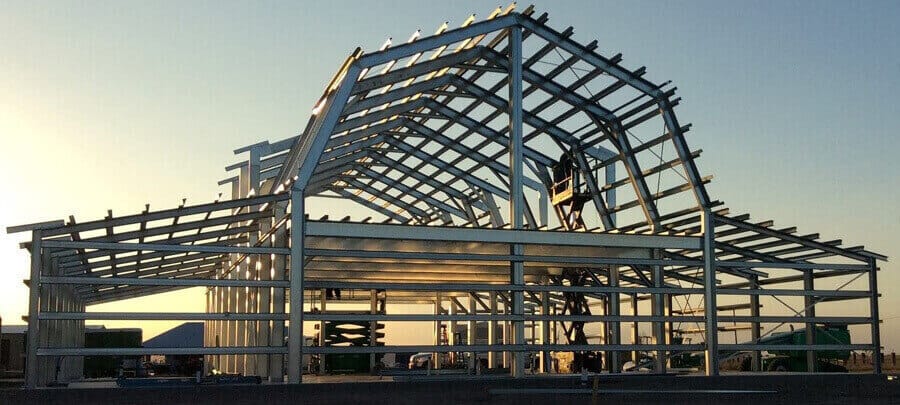
Steel Specification
Steel structure materials commonly used in different countries:
USA: ASTM A36, ASTM A572, ASTM A992, ASTM A514, ASTM A709, etc. Among them, ASTM A36 is one of the most commonly used low-carbon steel materials.
Europe: S235JR, S275JR, S355JR, S420MC, S460MC, etc. Among them, S355JR is one of the most commonly used structural steel materials.
China: Q235, Q355, Q420, Q460, Q690, etc. Q235B and Q355B are the most commonly used low-carbon steel materials.
Japan: SS400, SM490, SM520, SM570, etc. SS400 is one of the most commonly used structural steel materials.
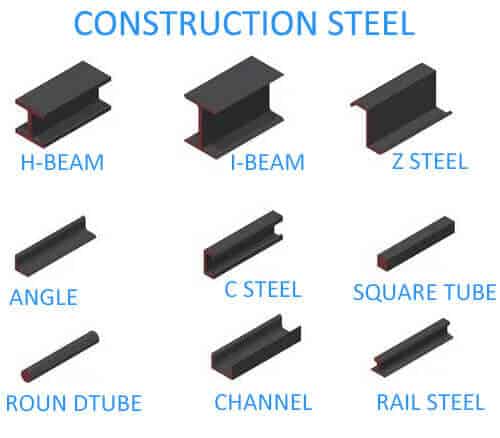
Section steel
Many section steel types exist, including solid, long steel strips with specific cross-sectional shapes and sizes.
Angle steel
Angle steel, commonly known as angle iron, is a long strip of steel perpendicular to each other and forms an angle. There are equilateral angle steel and unequal angle steel. The two sides of an equilateral angle are equal in width. Its specifications are expressed in millimeters of side width x side width x side thickness. For example, “∠30×30×3” means equilateral angle steel with a side width of 30 mm and a side thickness of 3 mm.
Round steel
Round steel refers to a solid steel strip with a circular cross-section. Its specifications are expressed in millimeters of diameter.
Channel steel
Channel steel is a long strip of steel with a grooved cross-section.
Steel plate
It is a flat steel material with a large aspect ratio and surface area. According to the thickness, it can be divided into three types: thin plate (thickness<4mm), medium plate (thickness 4-25mm), and thick plate (thickness>25mm)
Steel pipe
It is a long strip of steel with a hollow section. According to its cross-sectional shape, it can be divided into round pipes, square pipes, hexagonal pipes,s, and various special-shaped cross-section steel pipes. According to different processing technologies, it can be separated into two categories: seamless steel pipe and welded pipe.
Steel Structure Detail for Rigid Steel Frame Structure:
Due to its superior performance and wide adaptability, the portal frame is widely used in various industrial, commercial, and public buildings as the core load-bearing structure of a single-story light steel building. Its unique plane load-bearing system can flexibly combine steel frame units of different heights and spans to meet the structural requirements of various buildings, showing excellent design flexibility.
Regarding the facade layout, the portal frame has a high degree of variability, and the plane layout is almost not subject to any restrictions. Designers can freely adjust it according to actual needs. The steel frame structure can adopt a uniform cross-section design for ease. A variable cross-section design allows deduction, effectively to steel, and improves the economy through a variable cross-section design.
The construction period of the portal frame is short, and no sizeable mechanical equipment is required, significantly reducing the portal frame’s construction perioded steel plate roof design provides ideal conditions for long slope drainage, often allowing the form of construction spacious space with a single ridge and double slopes, particularly long-slope large spans and large spaces. This design is
In this structural system, between secondary components such as purlins and panels, purlins not only support the load transmitted by the panels but are also affected by the panels’ skin effect. At the same time, as the main load-bearing structure, the steel frame not only bears the load of the panels and secondary components but also enhances its stability by supporting the secondary structure.
A complex mechanical relationship of mutual support and constraint is formed between the primary and secondary structures and between the secondary structure and the panels to achieve an ideal balance between strength and economy.
The portal frame system can meet different usage requirements. Its economical and reasonable structural design makes it widely used in large public buildings, such as industrial plants, warehouses, gymnasiums, supermarkets, and hangars.
The portal frame provides a stable and efficient solution, especially in earthquake-prone areas with low foundation-bearing capacity or a scarcity of traditional building materials. Its unique advantages and wide adaptability are evident.
The Type of Portal Steel Frame
The portal steel frame structures can be classified into various types, including single-span (represented by Figure a), double-span (depicted by Figure b), multi-span (represented by Figure c), cantilever steel frame (depicted by Figure d), and steel frames with adjacent frames (represented by Figure e). The connection between the columns and roof beams in multi-span rigid frames follows a hinged pattern. Single-slope roofs (illustrated by Figure f) are a common feature in these structures.
A multi-span rigid steel frame consisting of multiple double-slope roofs is viable (as seen in Figure G). The beam-column cross-section can be uniform or vary in size, and the columns can be either hinged or rigidly connected at the base.
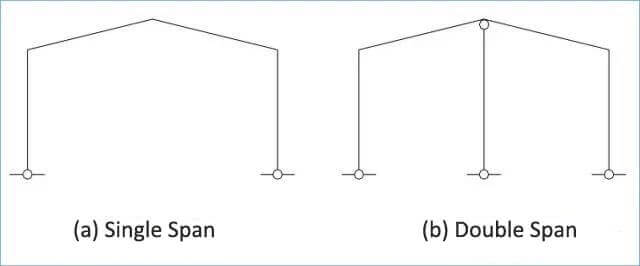
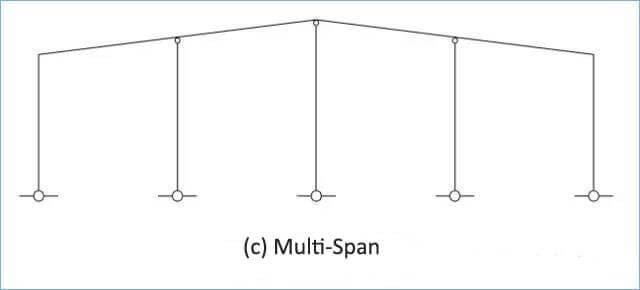
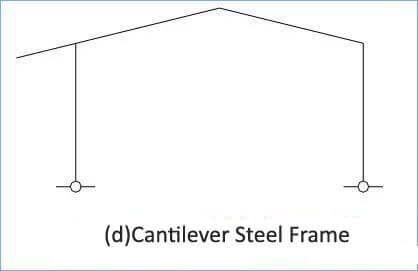

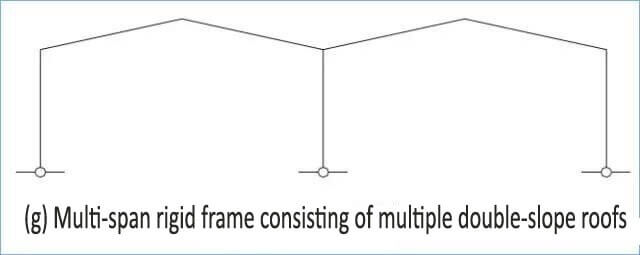
Length and Width of Steel Building :
Adhering to the general principle that the length exceeds the width, using steel in a rigid frame can be optimized. This reduces steel requirements and creates a more efficient bracing system, reducing the overall metal consumption in the bracing system.
Example 1: The building’s size is 60x50m; 60 m should be used as the length and 50m as the width, that is, 60 (L) x 50 (W), not 50 (L) x 60 (W).
Column Distance
Standard loads’ most cost-effective column spacing is between 7.5 to 9 meters. Beyond 9 meters, the usage of steel in roof purlins and wall girts becomes excessive, leading to higher overall costs. The standard load referred to here includes a live roof load of 0.3 KN/m2 and essential wind pressure of 0.5 KN/m2. The optimal column spacing should be reduced if the load is more significant. In the case of workshop buildings equipped with cranes weighing more than 10 tons, the ideal column spacing should be between 6 to 7 meters for financial reasons.
For uneven column spacing, placing columns closer together at the end spans is recommended, where wind loads are more substantial than the center span. Additionally, when utilizing a continuous purlin design, the end-span and mid-span tend to experience more deflection than other spans. By using smaller end-span column spacing, the design of the roof purlins becomes more manageable and cost-effective.
Example 1: Building length = 70m
Economical column distance is available: 1 @ 7 + 7 @ 8 + 1 @ 7 or 1 @ 8 + 6 @ 9 + 1 @ 8
Example 2: Building length = 130m, with a 10-ton crane
Economical column distance is preferable: 1 @ 5.5 + 17 @ 7 + 1 @ 5.5 or 20 @ 6.5
Determination of a reasonable span
The span of a metal building is primarily determined by its intended use and production processes. Some owners may even request that the manufacturer determine a more economical span based on the specific requirements of the building. A reasonable span should be defined based on the height of the steel building. When the column height and load remain constant, increasing the span can save space, minimize foundation costs, and provide overall cost benefits despite a slight increase in steel consumption for the rigid frame.
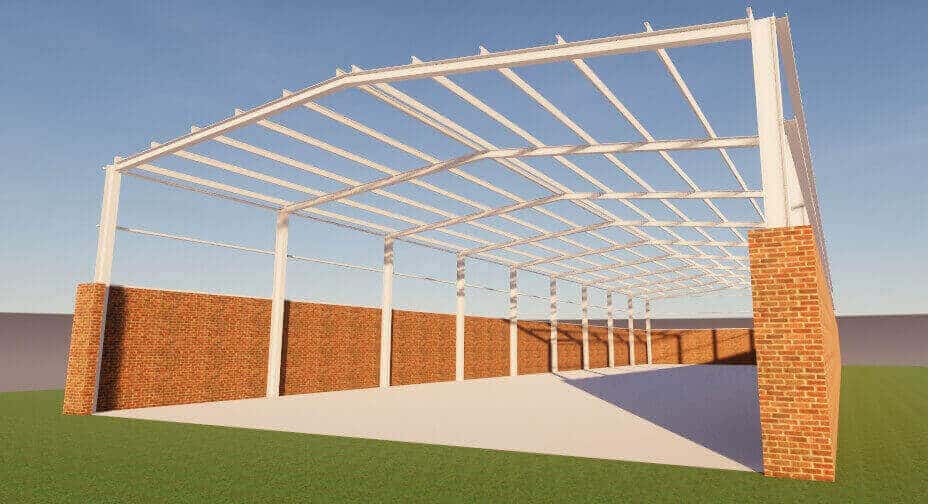
Calculations show that when the eaves height is 6 meters, the column spacing is 7.5 meters, and the load conditions are consistent, the steel consumption of the rigid frame (made of Q355B steel) ranges from 10-15 kg/m2 for widths between 18-30 meters. For rigid frame units between 21-48 meters, the steel consumption is 12-24 kg/m2. In cases where the eave’s height is 12 meters, and the width exceeds 48 meters, using a multi-span rigid frame with a sway column set in the middle can result in savings of over 40%. Therefore, choosing a more economical span based on specific requirements is recommended when designing a rigid portal structure rather than aiming for a large one.
Steel Structure Detail-Roof slope
The roof slope is determined based on several factors, including the roof structure, the slope length for drainage, and the height of the columns. Typically, roof slopes range from 1/10 to 1/30. Research has shown that different roof slopes significantly impact the amount of steel used in rigid steel frames. The following results are based on calculations and analysis of steel consumption under different roof slopes, with a single span of 42 meters and an eaves height of 6 meters.
The weight of a frame structure with a roof slope of 0.5:10 is 3682 kg, while that of a frame with a roof slope of 1:10 is 3466 kg. A frame with a roof slope of 1.5:10 weighs 3328 kg, and a roof slope of 2:10 weighs 3240 kg.
Therefore, for a single-span rigid steel frame, a way to reduce its weight is to increase the roof slope, as a larger slope means less steel is required. However, this does not hold for a multi-span frame. A steep slope will increase the metal used in the frame, resulting in a more extended inner column.
When the span of a building is substantial, increasing the incline can reduce the deflection of the roof steel beam. Based on research and calculations, the most economical slopes are as follows:
For multi-span buildings: 1:20
For single spans less than 45 meters: 0.5:10
For single spans less than 60 meters: 1.5:10
For single spans over 60 meters: 2:10
It’s worth noting that the presence of a parapet wall also influences the roof slope. A steep slope will increase the cost of the parapet wall.
Steel Structure detail: Height
The eave height plays a crucial role in determining the cost of a prefab steel building, affecting various aspects such as:
- Increasing the eave height increases the wall cladding, wall girt, and steel usage for columns.
- Without lateral bracing, the eave height has a more profound impact on the frame weight, resulting in increased wind load. If the height/building width ratio is above 0.8, changing the column foot from hinged to rigid may be necessary to control lateral displacement.
The eave height is determined by several factors, including:
- Required height at the eave.
- The net height of the mezzanine structure and the height of the mezzanine beam when present.
- The height of the crane beam and crane hook when a crane is available.
The temperature section of the rigid steel frame is subject to specific guidelines. The code stipulates that the building’s maximum length cannot exceed 300 meters and its width must not exceed 150 meters. The building’s design determines the first temperature-segmented expansion joint’s placement. It can be arranged as a double-column setup (as illustrated in Figure a) or a single-column expansion joint with slotted holes connected to the purlin (Figure b).


Steel Structure Detail-Bracing
(A) The uses of the Bracing
The use of bracing in the longitudinal structure of a rigid steel frame is crucial for the overall stability and functionality of the building. A comprehensive bracing system must be implemented to form a cohesive spatial structural system. The rigidity ensures the lightweight portal frame’s lateral stability in the width direction, which helps it resist lateral loads effectively.
The longitudinal structure of a steel frame is susceptible to instability in the length direction due to its weak stiffness. Installing bracing in the longitudinal direction is imperative to ensure its longitudinal stability. The bracing system must withstand various forces, including longitudinal wind loads, crane braking forces, earthquake forces, and temperature changes. When calculating the strength of the brace, the joints are typically treated as hinges, and the impact of eccentricity is ignored. The bracing system design considers the support provided by tie beams, making a two-way arrangement the preferred solution.
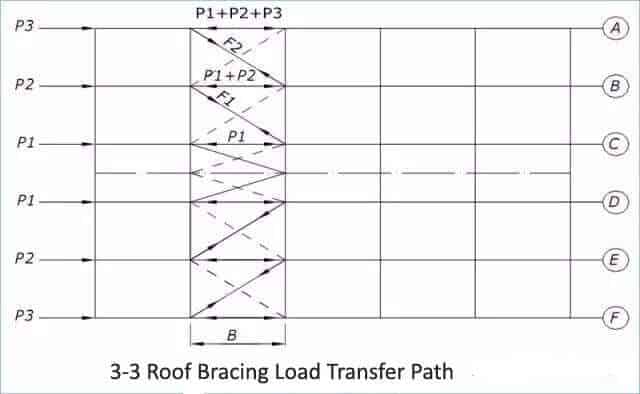
(B) Common types of bracing
Figures 3-3 show the standard configuration of roof bracing and how wind loads are transferred onto the gable wall. Figures 3-4 showcase the typical bracing systems between columns in rigid steel frames. A longitudinal structure may be considered when the bracing systems cannot be used due to the building’s design, functional requirements, or equipment placement. Utilizing the bending stiffness of the column’s weak axis is essential in this scenario.
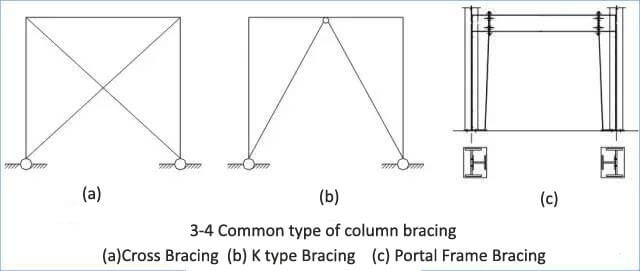
Stee Structure Detail-Basic principles of bracing settings
- Column bracing should be installed on the same span as the roof bracing. In cases where the door opening on the wall prevents this, the column bracing can be placed on the neighboring span.
- The distance between bracings should not exceed five spans. When no crane is available, a distance of 30 to 45 meters should be maintained. However, the distance should not exceed 60 meters when a crane is present.
- The roof bracing should be divided along the ridge line (Figure 3-3).
In the following situations, the installation of vertical-horizontal roof bracing needs to be considered.
- In the event of a removed column (when one or more columns are removed within the column network), longitudinal bracing will suffice, as depicted in Figure 3-5a.
- When the distance between columns is substantial, a false wall frame column may be used, as illustrated in Figure 3-5b.
- This will also be considered if the crane has a capacity of over 15 tons.
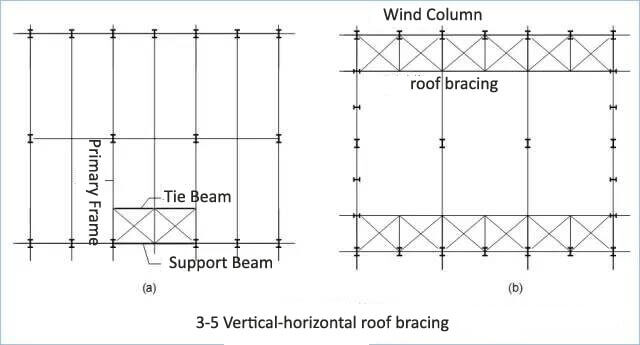
For buildings with widths exceeding 60m, it is advisable to reinforce the columns with additional bracing. In the absence of cross bracing, alternative bracing forms illustrated in Figures 3-4b and 3-4c can be employed. An alternative approach would be to augment the section size of the roof or column bracing without additional internal pillar support. However, in this scenario, it is critical to perform precise calculations of internal forces to guarantee the safety of the bracing system.
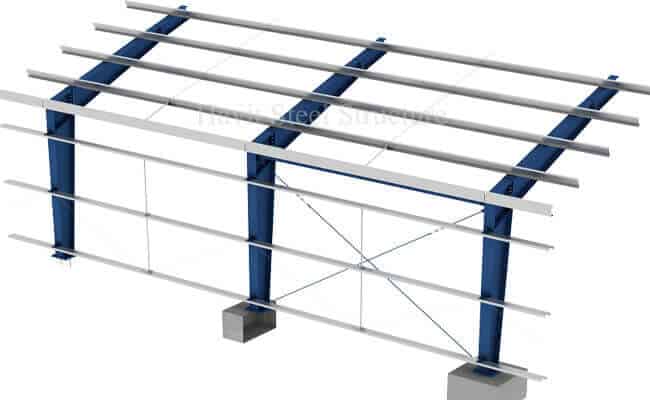
It is not advisable to combine different types of bracing within the same column, as this can result in suboptimal performance. Bracing with lower stiffness will not withstand the necessary forces, while bracing with higher rigidity will be subjected to excessive stress and risk damage. Cross braces are recommended as the primary form of column bracing to ensure optimal functioning.
In the following cases, the column bracing needs to be layered.
- For structures with high-low spans or large rain canopies, a double layer of bracing between columns at these locations is necessary, as shown in Figure 3-6a.
- Double-layer column bracing can be installed for structures with eave heights exceeding 9m, with the bracing angle included. The angle between the cross-bracing and the horizontal plane should be approximately 45° and not exceed 55°. The upper and lower bracing should be placed between columns. In end-opening rooms, it may be desirable to omit the lower bracing to reduce stress on the crane beam due to temperature changes, as shown in Figure 3-6b.
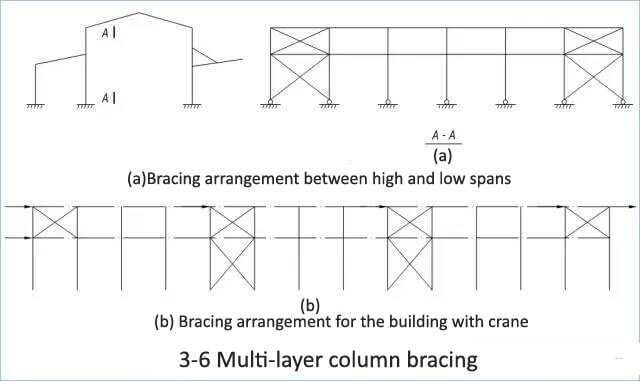
Round steel, angle steel, or round (square) pipe can be used for Column Cross Bracing.
Steel rod bracing is inadequate for column bracing subjected to significant internal forces or cranes with a lifting capacity exceeding 5 tons. In these scenarios, angle steel or round (square) pipes should be used as the column bracing material.
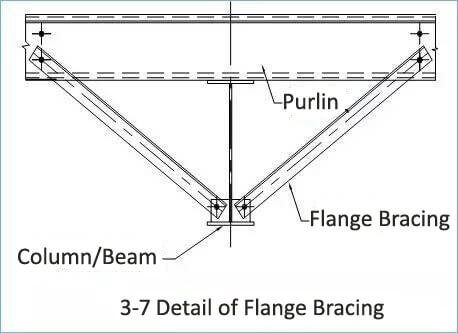
Steel Structure detail – use and setting of the flange bracing.
The primary purpose of the flange brace is to ensure the stability of both the beam’s lower flange and the column’s inner flange. It is attached to the lower flange of the beam on one end and the purlin on the other. For proper implementation, see Figure 3-7.
Steel Structure detail for Multi-floor Steel Frame Structure
The steel frame structure is a load-bearing system composed of beams and columns connected by rigid or hinged joints. This structural form consists of a frame of beams and columns to bear the horizontal and vertical loads generated during use.
In this structure, the walls of the house do not bear the load-bearing function but only play the role of enclosure and separation.
Multi-story steel frame structure is a unique alternative to traditional brick-concrete and concrete structures. During the construction process, steel plays a vital role as the primary load-bearing system.
The steel frame consists of frame beams, columns, beam-column connectors, corrugated steel plate composite floors and a solid foundation. The floor system comprises main beams, secondary beams and composite floors. Therefore, the installation of steel floor slabs, the tying of floor steel bars, and the pouring of concrete must be completed on-site.
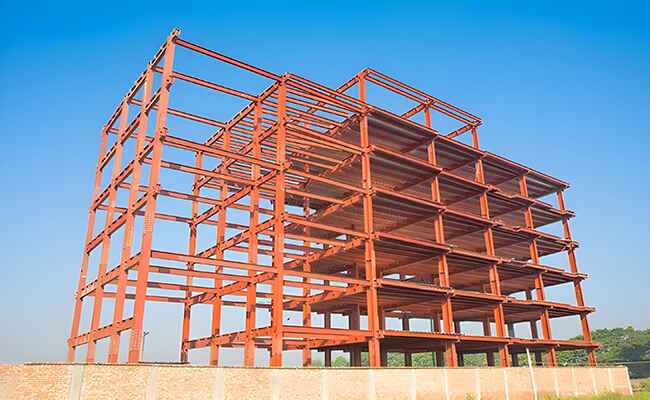
The Detail for Steel Frame Structure
Column Foot:
- During the installation of the steel column, the hinged column foot needs to be tightened with a cable wind rope, and a wedge-shaped iron block is set at the bottom to assist in fixing to ensure the timely connection with the adjacent steel column to form an overall stable structure;
- After the steel column is corrected, secondary grouting should be carried out. The upper part of the short column foundation needs to be roughened. Since the grouting material has micro-expansion properties, the thickness of the secondary grouting layer shall not be less than 50mm and should not exceed 100mm; when the anchor bolt diameter is greater than 42mm, the thickness of the grouting layer shall not be less than 100mm;
- Before installing the steel column, the shear groove must be cleaned and roughened, and its size must be checked to ensure that there is no foreign matter in the groove;
- The column foot bolt pad should be welded and fixed to the bottom plate of the steel column foot. The weld is a fillet weld, and its height shall not be less than half the thickness of the pad.
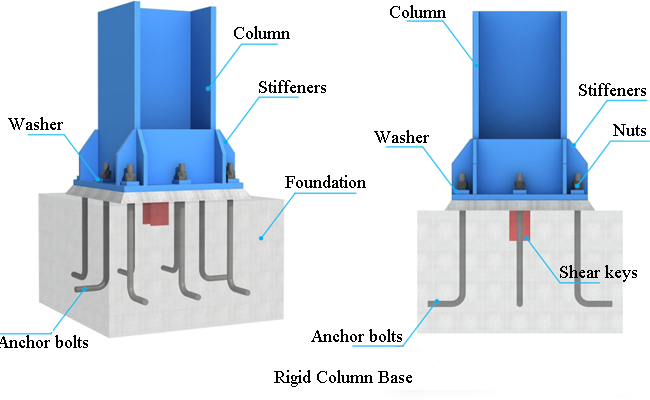
Beam-column rigid joint:
- The web of the H-shaped steel beam is connected to the web of the steel column bracket by high-strength bolts, and the upper and lower flange plates are connected to the flange plates of the steel column bracket by butt welding.
- The steel beam connection adopts full penetration welds with grooves, following the “Steel Structure Welding Code GB50661-2011” and relevant national standards and regulations. The steel structure manufacturing plant should complete the groove form and size.
- The extension length of the welding pad and the arc-extinguishing plate should be at least 10 mm longer than the steel beam flange plate.
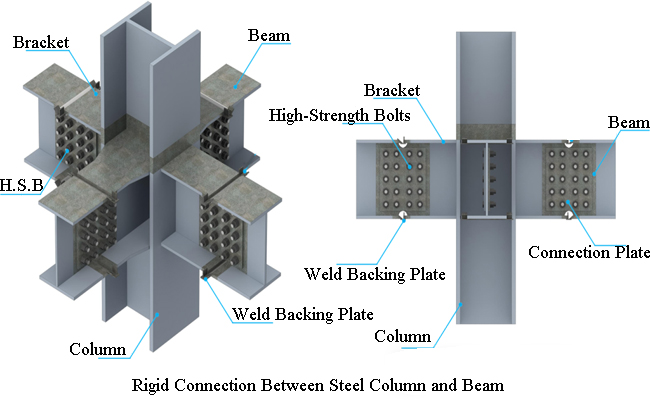
Main and secondary beam rigid connection:
- The web of the H-shaped steel secondary beam is connected to the ear plate of the main steel beam by bolts, and the upper and lower flange plates are connected to the main steel beam connection plate by welding, or the upper and lower flanges and webs are connected to the main steel beam bracket by full welding;
- The steel beam connection adopts groove full penetration welds and strictly implements the “Steel Structure Welding Code GB50661” and relevant national standards and regulations. The groove form and size of the groove full penetration weld will be completed in the steel structure manufacturing plant, and the welding quality will be ensured.
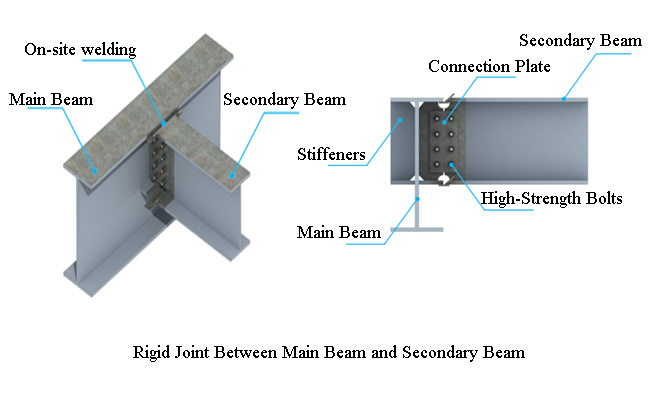
Main and secondary beam hinged connection:
The web of the H-shaped steel secondary beam is connected to the ear plate of the main steel beam by bolts, and the upper and lower flange plates do not need to be connected.
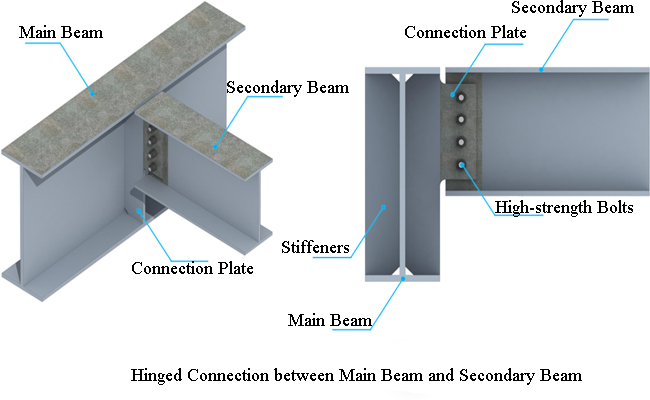
Steel Structure Detail for Truss Structure
Truss structures are a prevalent form in metal construction, frequently utilized in large public structures such as stadiums, railway stations, and airports. This structural form has seen increased use in recent years with the rapid advancement of high-speed railways and intercity transit stations. Truss structures boast several vital features, including wide spans, versatile shapes, and ample design options.
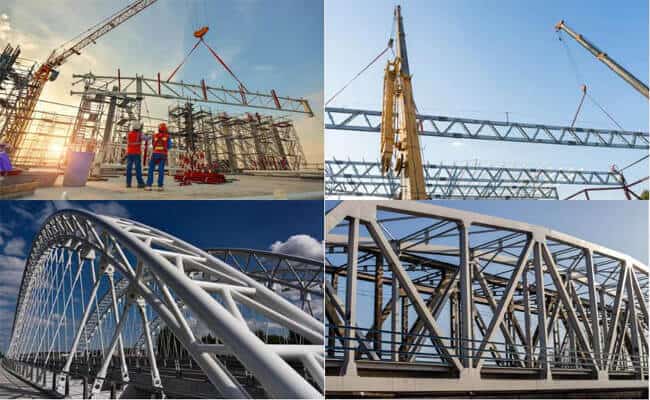
Steel trusses typically consist of chords, webs, and gusset plates. Various types of steel trusses are available depending on the materials utilized for the structural members. Some common types include steel pipe trusses, H-shaped steel trusses, box-section trusses, and angle steel trusses.
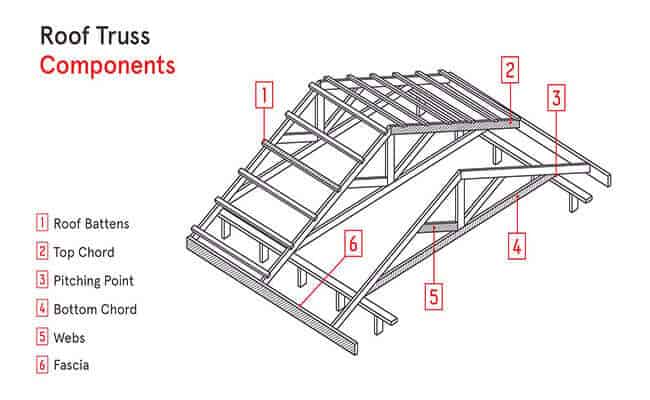
1. Angle Steel Truss
Angle steel trusses are commonly used in roofing systems and are famous for industrial buildings such as factories and warehouses. These trusses typically consist of a T-shaped section welded together using double-angle steel.
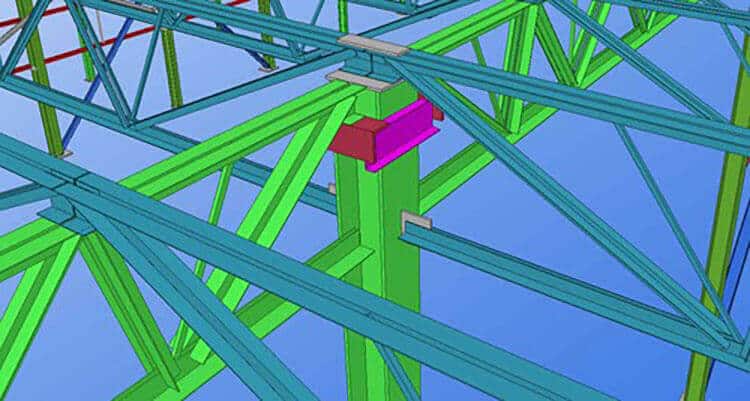
2. Steel pipe truss:
The steel pipe truss is composed of round pipes, square tubes, and rectangular tubes. The connection between the pipes is achieved by intersecting them.
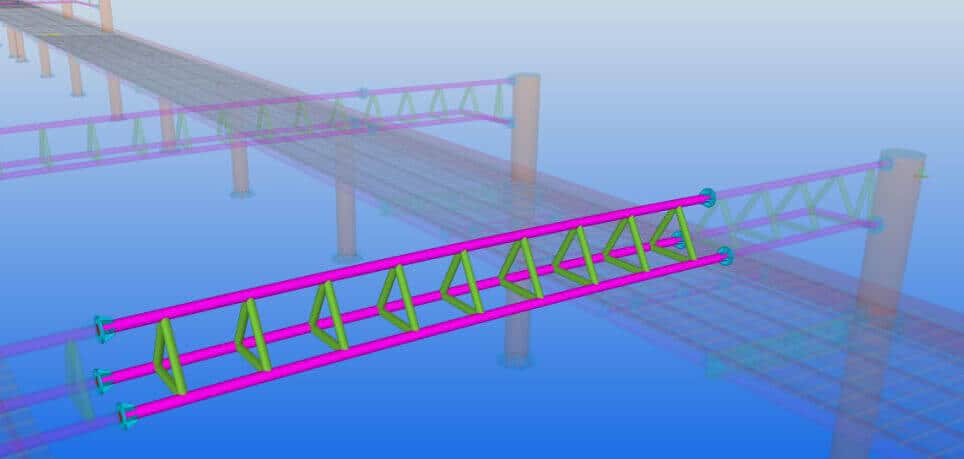
3. H-shaped steel truss:
The H-shaped steel truss has H-shaped steel elements for both the chords and webs, or H-shaped steel for the chords and round pipes, square tubes, or rectangular tubes for the webs.
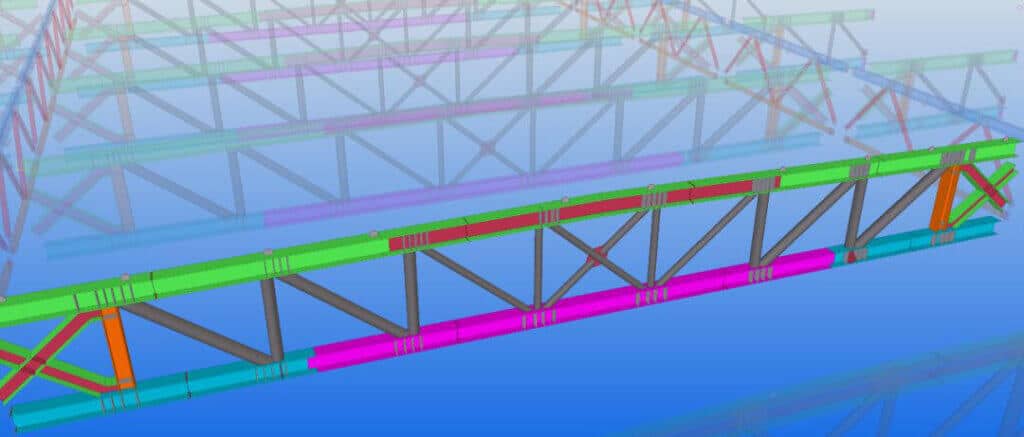
4. Box-shape steel truss:
The box-shaped steel truss features box-shaped chords and webs, or box-shaped chords with round pipes, square tubes, or rectangular tubes as the webs. The webs and chords are connected through intersecting when the webs are round pipes, square tubes, or rectangular tubes.
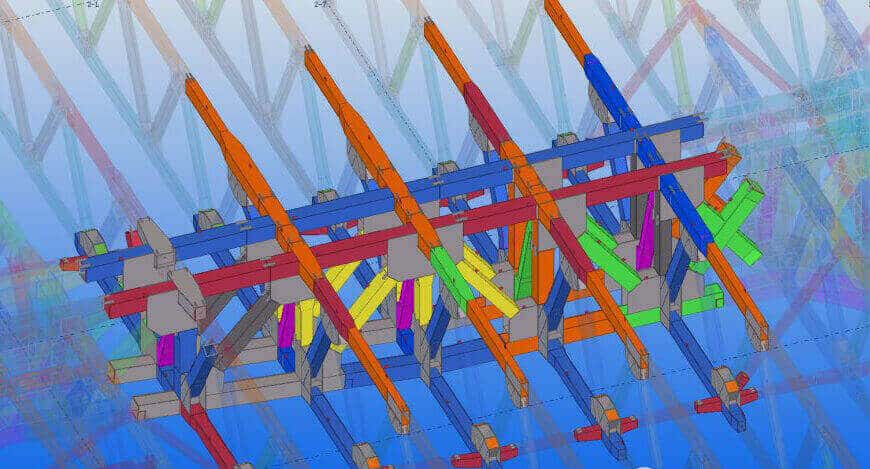
Steel Structure Design
Steel structure design should include the following contents:
- Structural scheme design, including structure selection and component arrangement;
- Material selection and cross-section selection;
- Analysis of functions and effects;
- Check the limit state of the structure;
- Construction of structures, components, and connections;
- Requirements for production, transportation, installation, anti-corrosion, and fire protection;
- Unique performance design for structures that meet special requirements.
Steel structure design standards in different countries:
United States: American steel structure design standards and specifications are formulated and issued by the American Institute of Steel Construction (AISC), including ASD (Allowable Stress Design) and LRFD (Load and Resistance Factor Design), two design methods.
Canada: The Canadian Standards Association (CSA) formulates and issues Canada’s steel structure design standards and specifications, including S16-14 and S16S1-19.
Europe: European steel structure design standards and specifications are formulated and issued by the European Committee for Standardization (CEN), including EN 1993-1-1, EN 1993-1-5, EN 1993-1-8, EN 1993-1-10, EN 1993-1-11, EN 1993-1-12, EN 1993-1-13, EN 1993-1-14, EN 1993-1-15 and EN 1993-1-16, etc. standard.
Japan: The Japanese Society of Civil Engineers (JSCE) and the Japan Iron and Steel Federation (JISF) jointly formulate and issue Japan’s steel structure design standards and specifications. These include JIS G3101 and multiple standards such as G3192, JIS G3193, JIS G3444, JIS G3466, JIS G3468, and JIS A5525.
China: The National Standardization Management Committee formulates and publishes China’s steel structure design standards and codes, including GB 50017, GB 50018, GB 50009, and GB 50011.
Basic principles of steel structure design
The basic principles of steel structure design are to ensure the safety, stability, and economy of the structure. During the design process, it is necessary to fully consider the structure’s stress conditions, usage environment, and engineering requirements to achieve the best design effect.
Steel structure design requires reasonable component selection based on the project’s needs and load requirements.
Steel structures have many components, including steel columns, beams, trusses, etc. Different elements have different advantages under various stress conditions. For example, steel trusses are usually selected as the main load-bearing components for long-span building structures. In contrast, frame structures composed of steel columns and beams are often used for large factories or warehouses. Therefore, a reasonable selection of components is a critical step in steel structure design.
Load calculation is an indispensable part of steel structure design.
According to actual engineering conditions and relevant standards, various loads on the structure, including static, dynamic, wind, earthquake, etc., must be accurately calculated. Accurate load calculation can effectively guarantee the safety and stability of the steel structure.
Connection design is also a crucial part of steel structure design.
Reasonable connection design can improve the structure’s overall stability and load-bearing capacity. For example, using high-strength bolt connections can improve the mechanical performance of components, reduce the structure’s material consumption, and thereby reduce costs. At the same time, reasonable connection design can simplify the construction process and improve the project’s efficiency.
Features of steel structure:
1. Save steel consumption and save investment
The steel consumption of the light steel structure is generally 8~15kg/m2, and the steel consumption of the single-story light steel warehouse is 16~30kg/m2. It is close to or even lower than the steel consumption of the reinforced concrete structure under the same conditions and can Save a lot of wood, cement, and other building materials. Therefore, the steel structure can significantly reduce the self-weight of the structure, generally about 1/2~1/3 of the ordinary steel structure and 1/10~3/10 of the reinforced concrete. It saves construction funds compared to traditional reinforced concrete and ordinary steel structures.
2. Prevent leakage; the effect is ideal
The roof and wall materials of the steel structure mainly use colored profiled panels or sandwich panels, and the purlins are thin-walled C-shaped or Z-shaped steel purlins that are lightweight. The roof slope design of the steel structure factory building is generally 1/10~1/15. After the corrugated metal sheet is reliably connected and fixed on the steel sassafras, the rainwater can be directly discharged to the inner and outer gutters along the pressure profile and quickly drained to the sewer pipe or the outdoor ditch through the rigid plastic PVC pipe to ensure the requirements of the factory building against rainwater leakage.
3. No piling required, shortening the construction period
Due to its lightweight, the steel structure building generally only needs to use the concrete foundation under the column to meet the load-bearing requirements. As a result, the construction cycle is shortened, and the construction investment is saved.
4. Fast delivery and easy installation
The materials used for the steel structure are all conventional. There are also many manufacturers of profiled plates and accessories used in the enclosure system, as well as C-shaped and Z-shaped steel purlins. Generally, a single-story factory building or warehouse of about 10,000 m2 only needs 3 to 4 purlins from design to delivery. It can shorten the construction period by half or even more than a factory building with a reinforced concrete structure.
5. The appearance is beautiful, and the interior is empty
The color of the steel buildings can be selected according to the needs, adjusted, and combined at will. Roof-profiled panels, especially colored-profiled panels for walls, are lightweight, highly efficient, bright colors, and beautiful in shape. In addition to being mainly used as a wall, it also functions like a decorative panel.












